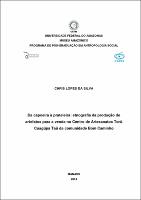| ???jsp.display-item.social.title??? |


|
Please use this identifier to cite or link to this item:
https://tede.ufam.edu.br/handle/tede/3915| ???metadata.dc.type???: | Dissertação |
| Title: | Da capoeira à prateleira: etnografia da produção de artefatos para a venda no Centro de Artesanatos Torü Cuagüpa Ta da comunidade Bom Caminhoũ |
| ???metadata.dc.creator???: | Silva, Chris Lopes da  |
| ???metadata.dc.contributor.advisor1???: | Barbosa, Priscila Faulhaber |
| ???metadata.dc.description.resumo???: | Este trabalho pretende descrever o circuito da produção de artefatos no Centro de Artesanatos , procurando mostrar como um grupo da etnia Ticuna Torü Cuagüpa Taũ transforma e insere sua produção artesanal na economia de mercado, destacando os aspectos de dominação e autonomia pertinentes nesse processo. O Centro fica localizado na aldeia Bom Caminho, município de Benjamin Constant, na tríplice fronteira do Brasil com o Peru e a Colômbia. O povo Ticuna possui uma forte tradição cultural de fabricação de artefatos. A memória coletiva reproduz que no surgimento da humanidade, e os heróis culturais, e suas irmãs e Ipi, Mowatcha Yoi‟i , teciam artefatos enquanto estavam no joelho de e, ao tocarem a AikünaNgutapa terra, trouxeram consigo os primeiros objetos. No mundo material, até a década de 80, a produção de artefatos em Bom Caminho seguia a tradição cultural para atender ao contexto doméstico e manter pequenos circuitos de trocas estabelecidos pelas relações interétnicas. Por meio de projetos integradores e outros alicerçados no discurso do desenvolvimento sustentável a produção foi e vem sendo incentivada para o mercado, modificando a economia tradicional. O artesão enquanto agente social integra uma categoria de trabalho exterior à sua cultura, potencializada pelo pensamento econômico hegemônico. Entretanto, os artesãos do Centro de Artesanatos desessencializaram esta categoria assumindo a identidade Ticuna. Enquanto grupo étnico, construíram uma rede de relações de fronteiras étnicas embasada num tipo especial de consumo, onde mercadorias e pessoas circulam e possuem vida social. |
| Abstract: | This work want to describe the circuit of production artifacts in workmanship Center Torü Cuagüpa Taũ, trying to show how a group of Ticuna ethnicity transforms and inserts its craft production in a market economy, highlighting the relevant aspects of domination and autonomy in the process. The Center is located in the village Bom Caminho, town of Benjamin Constant, the triple border between Brazil and Peru and Colombia. The Ticuna has a strong cultural tradition of manufacturing artifacts. The collective memory reproduces the emergence of humanity, Yoi'i and Ipi, cultural heroes, and his sisters and Mowatcha Aiküna, weaving artifacts while were in the knee of Ngutapa and, to touch the earth brought with them the first objects. In the material world, until the 80s, the production of artifacts in Bom Caminho followed the cultural tradition to meet the domestic context and keep small circuits of exchange established by inter-ethnic relations. By integrating projects and other grounded in the discourse of sustainable development production was and is being encouraged to market by modifying the traditional economy. The artisan as a social agent integrates an category external of Ticuna work culture, potentiated by hegemonic economic trough. However, artisans of Center Crafts work deconstructed this category assuming Ticuna identity. While ethnic group, built a network of relationships based upon a particular type of consumer ethnic borders, where goods and people circulate and have social life. |
| Keywords: | Etnicidade Ticuna Artefatos Artesanato Ethnicity Ethnicity |
| ???metadata.dc.subject.cnpq???: | CIÊNCIAS HUMANAS: ANTROPOLOGIA |
| Language: | por |
| ???metadata.dc.publisher.country???: | Brasil |
| Publisher: | Universidade Federal do Amazonas |
| ???metadata.dc.publisher.initials???: | UFAM |
| ???metadata.dc.publisher.department???: | Museu Amazônico |
| ???metadata.dc.publisher.program???: | Programa de Pós-graduação em Antropologia Social |
| Citation: | SILVA, Chris Lopes da. Da capoeira à prateleira: etnografia da produção de artefatos para a venda no Centro de Artesanatos Torü Cuagüpa Ta da comunidade Bom Caminhoũ. 2014. 167f. Dissertação (Mestrado em Antropologia Social) - Universidade Federal do Amazonas, Manaus, 2014. |
| ???metadata.dc.rights???: | Acesso Aberto |
| URI: | http://tede.ufam.edu.br/handle/tede/3915 |
| Issue Date: | 15-Aug-2014 |
| Appears in Collections: | Mestrado em Antropologia Social |
Files in This Item:
| File | Description | Size | Format | |
|---|---|---|---|---|
| Dissertação_Chris Lopes da Silva_PPGAS.pdf | Dissertação - Chris Lopes da Silva | 5.08 MB | Adobe PDF |  Download/Open Preview |
Items in DSpace are protected by copyright, with all rights reserved, unless otherwise indicated.




